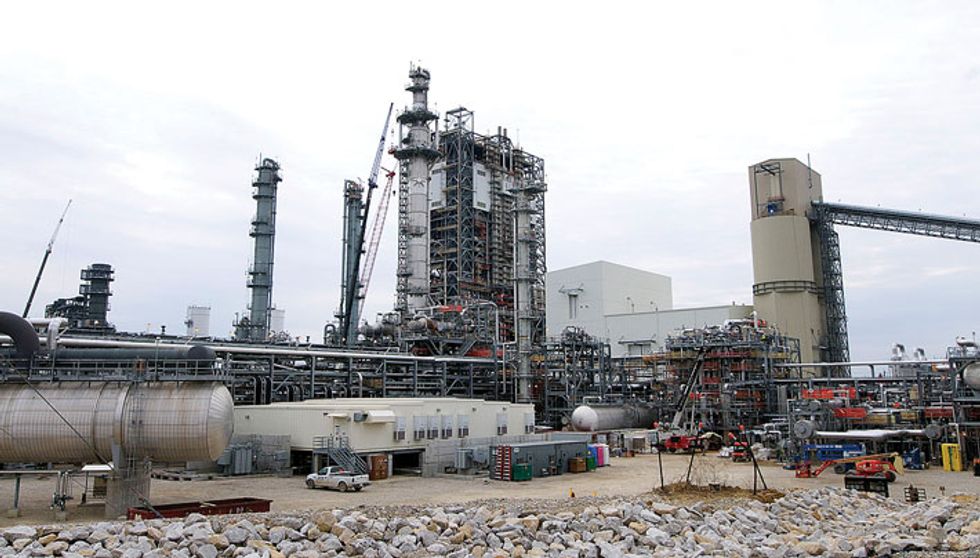At 250 megawatts, the facility, known as GreenGen, is the world’s largest coal-fired integrated gasification combined cycle (IGCC) generator. It’s also the first built explicitly as a test bed for capturing carbon. This combination of carbon capture and commercial scale is needed to evaluate coal gasification’s potential contribution to stopping and reversing human-accelerated climate change. “We still have no plan as nations or as a world to make really deep greenhouse-gas emissions cuts. We have not economically vetted most of our important options, including IGCC plants such as GreenGen,” says Friedmann.
GreenGen more closely resembles a refinery than a generating station. IGCC plants turn coal into a blend of gases before burning those gases to drive both gas and steam turbines. Unlike all IGCC plants that preceded it, GreenGen is designed to support an additional process whereby its carbon waste is extracted before combustion. Gases from the gasifier react with steam to produce hydrogen to fire the plant’s turbines and a pure stream of carbon dioxide that is far easier to capture than the diffuse CO2 in a conventional power plant’s flue gases.
GreenGen and the handful of other IGCC coal plants in various stages of construction worldwide—including another plant in China and two in the United States—are the sole survivors among dozens of IGCC projects proposed and shelved over the past decade. Most fell by the wayside only in the past few years. A push for carbon legislation in the United States collapsed, as did the 2009 climate treaty negotiations held in Copenhagen. Without such measures, utilities have no incentive to invest in carbon capture. Over the same period, coal progressively lost its status as the cheapest fuel for power generation, as hydraulic fracturing operations flooded the natural gas market and slashed gas prices.
The resulting IGCC casualties include even FutureGen, the flagship project in the U.S. Department of Energy’s Clean Coal program and the inspiration for GreenGen. The Bush administration killed FutureGen in 2008 amid rising costs. The project may return under President Obama but as a test of a simpler but even less-proven low-carbon coal scheme known as oxyfuel combustion.
loyaltyshopping_cartlocal_librarydelete
Survivors such as China’s GreenGen could renew IGCC’s appeal if they prove the technology’s commercial promise. But critics say that delays and cost overruns in these projects may well undermine that. GreenGen started more than a year later than projected. And even proponents say it could take the remainder of this year for Huaneng Group, the state-owned utility behind GreenGen, to work out its kinks.
Cost overruns and a political scandal have blackened the image of the next IGCC likely to start up: a 618-MW plant in Edwardsport, Ind., that could begin operating later this year, one year behind schedule. Last year Duke Energy, based in Charlotte, N.C., sought state approval to charge Indiana ratepayers US $2.7 billion for the project, whose construction budget has ballooned from $1.9 billion to $3.3 billion since work began in 2007. Allegations of improper lobbying have prompted the firing of several Duke executives and the indictment of Indiana’s top utility regulator on four counts of “official misconduct.” In April the utility trimmed its request to $2.6 billion and took a $420 million loss on its balance sheet.
Critics of coal-fired generation see even on-budget IGCC as a poor investment, citing environmental liabilities. Sulfur and heavy metals captured by the plant must be disposed of, and opponents question whether sequestering captured carbon underground will prove technically viable and socially acceptable. If it doesn’t, such plants could face penalties under future carbon markets and regulations.
“In our opinion, they’re investing in the wrong technology. You’re much better off building infrastructure that’s proven, like wind or solar power,” says Andrew Behar, CEO of As You Sow, a nonprofit shareholder-action group based in San Francisco that challenged Duke Energy’s investment strategy at the firm’s annual meeting in May.
China may ultimately offer more fertile ground for IGCC technology and carbon sequestration. Despite an aggressive shale-gas production program, replacement of coal by natural gas is hard to imagine in China. As Friedmann puts it, “There’s just not enough gas. If China gets everything they want in natural gas, they may decide not to build 100 000 MW of coal generation over the next five to eight years. But they will still build 400 000.”
A correction to this article was made on 29 May 2012.

